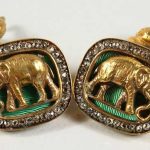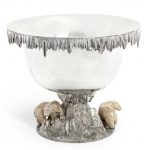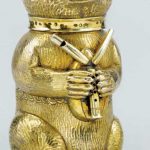Silver Bears. Silver was one of the seven metals of antiquity that were known to prehistoric humans and whose discovery is thus lost to history. In particular, the three metals of group 11, copper, silver, and gold, occur in the elemental form in nature and were probably used as the first primitive forms of money as opposed to simple bartering. However, unlike copper, silver did not lead to the growth of metallurgy on account of its low structural strength, and was more often used ornamentally or as money. Since silver is more reactive than gold, supplies of native silver were much more limited than those of gold. For example, silver was more expensive than gold in Egypt until around the fifteenth century BC, the Egyptians are thought to have separated gold from silver by heating the metals with salt, and then reducing the silver chloride produced to the metal. Reference: Wikipedia
Below are some examples of silver bears.
A GOOD PAIR OF RUSSIAN SILVER GILT, ENAMEL AND DIAMOND CUFFLINKS, mounted with elephants and a bear shape toggle to the retaining chain.
Sold for £800 at John Nicholson Auctioneers in 2019
An Italian silver bear, Buccellati, 20th century realistically modeled as a seated bear with outstretched paws and intricately chased fur base engraved Buccellati Italy, Sterling and the number 4 height 12 in. 30.5cm 137oz 10dwt 4273g
Sold for 16,250 USD at Sotheby’s in 2014
A Victorian silver ‘Polar Bear’ ice bowl by Henry Wilkinson, Birmingham 1874, with diamond registration mark The rim applied with pendant icicles, the rockwork base with two unmarked modelled polar bears, crested side, height 13cm, diameter 16cm, weight total 30.5oz.
Sold for £ 1,750 inc. premium at Bonham’s in 2017
Standing cup; silver-gilt; chased; form of bear seated on hind quarters and grasping staff with right paw; removable cast head with buckled collar with quatrefoils in relief; oval base with gadrooned edge; inscribed. Formerly attributed to: Marx Weinold Date 1800-1898
Reference: © The Trustees of the British Museum
A German silver-gilt cup and cover in the form of a bear Circa 1600, unmarked The seated figure textured to simulate fur, the detachable head with collar with ring, the body with similar ring and chased chain belt, the bear clasping a pair of bag-pipes in his paws 5 7/8in. (13cm.) high 10oz. (320gr.)
Sold for GBP 28,680 at Christie’s in 2003
Tiffany & Co. Parcel Gilt Sterling Silver Ice Bowl Designed by Edward C. Moore, circa 1877 The circular bowl decorated with Japanesque water lilies and dragonflies, on a base of ice dripping with icicles, with two polar bears. Diameter of bowl 10 1/4 inches, length 11 1/2 inches, approximately 158 ounces. The Japanesque style was hugely popular in the United States after Meiji Japan showed art and decorative arts at the Centennial Exhibition held in Philadelphia in 1876. Tiffany & Co. under Edward C. Moore embraced Japanese design with great enthusiasm creating some of the most inventive and beautiful silver of the late 19th century. The polar bears modeled by Eugene J. Soligny were a popular addition to punch and ice bowls, used to celebrate the purchase of Alaska from Russia in 1867. While the mixing of polar bears and dragonflies may appear unusual to modern eyes, at the time of its creation, this ice bowl would have united the very latest trends in fashion and politics. In the time before refrigeration, ice and chilled drinks were a great luxury afforded to only the wealthiest of Americans. The serving of ice was a grand spectacle that Tiffany & Co. perfectly presented with this stunning ice bowl. Guests would thus have been impressed not only by their hosts cutting edge taste and knowledge of national politics, but also by their generous wealth.
Sold for $125,000 (includes buyer’s premium) at Doyle New York in 2019





